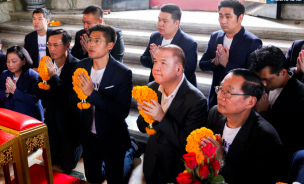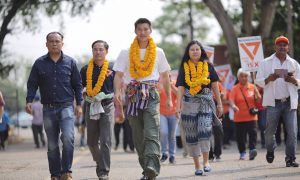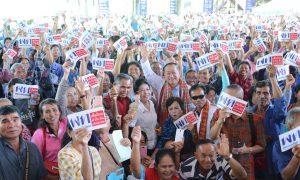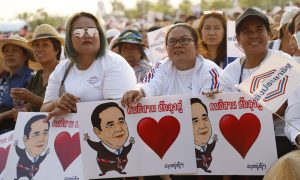On 7 March 2019, Thailand’s Constitutional Court dissolved the Thai Raksa Chart party for having proposed the King’s sister, Ubolratana Mahidol, as a prime ministerial candidate in the election scheduled for 24 March. Was this decision protecting democracy by preventing Thailand from becoming a ‘ruling monarchy’, as the Court argued in its ruling? Or was it advancing autocratisation by punishing the party which proposed the candidate who posed the most serious challenge to the army?
Since the military seized power in a coup on 22 May 2014, before declaring martial law and abolishing the constitution, the Constitutional Court has remained in place without much change to its composition. Most of the justices, whose terms were supposed to expire in 2017, saw their tenure extended by order of the junta. The Court has continued delivering rulings, albeit with limited activity, issuing yearly between one decision (in 2015, when the country was under Martial Law until April) and seven decisions (in 2018). The Thai Raksa Chart ruling was the Thai Constitutional Court’s third in 2019.
One may see the existence of a constitutional court in a military dictatorship as a puzzle. Why did the Thai military keep the Constitutional Court in place while abolishing the Constitution? What can possibly be the role of a constitutional court in such a context?
The Court’s function: legitimation, cooptation and repression
The creation of a constitutional court is most often seen as a symbol of departure from military dictatorship. Thailand’s Constitutional Court shares a similar genesis. The Asian Spring, which diffused in Southeast Asia in the late 1980s, reached Thailand in 1992. It resulted in the fall of General Suchinda Krapayoon´s military dictatorship and the drafting of the 1997 Constitution, which provided for the creation of a constitutional court with strong autonomy, independence, judicial discretion and wide-ranging powers.
But while Thailand’s Constitutional Court was celebrated at first as a sign of a successful story of democratisation, it eventually morphed into an institutional anomaly partly responsible for Thailand’s return to military rule. During the two decades of its existence, it paved the way for two military coups and staged one “judicial coup” that effectively put the opposition in power. Thailand has been described as a juristocracy thriving on abuses of judicial review.
Since 2014 and the establishment of one of the very few full-fledged military dictatorships left in the world, the role of the Constitutional Court has been to answer the key needs of any authoritarian regime seeking stabilisation—building legitimation, ensuring cooptation and organising repression—through constitutional means.
Much of the Thai Constitutional Court´s activity has been dedicated to validating the constitutional framework laid out by the junta. This includes validating the referendum that approved the 2017 constitution, validating the changes made to the constitution after it was adopted by referendum, and validating organic acts (rules of near-constitutional value, placed above legislation in the hierarchy of norms). Most of the rulings delivered in 2018 belonged to the latter category—the Constitutional Court ruled, for instance, on the Organic law on Political Parties, on the Election of Members of Parliament, on the National Anti-Corruption Commission, on the Ombudsmen, and on the Selection of Senators.
This links to the second function of the Constitutional Court: organising cooptation through the Constitution. Validating organic acts meant validating constitutional means of cooptation—in the Senate, and in the various independent constitutional organs and committees channelling the military and its supporters.
The third function of the Constitutional Court is to neutralise opposition political parties. Even though political parties were illegal by decree of the junta until mid-2018, the Constitutional Court continued to rule on the dissolution of Thai political parties throughout 2015–18. To do so, it relies on (the threat of) dissolution, electoral bans and annulment of elections. As the Court cannot initiate cases on its own initiative, it relies on other constitutional organs to file cases, most notably the Ombudsman and the Election Commission—which can also cancel individual elections of members of parliament and ban them from politics.
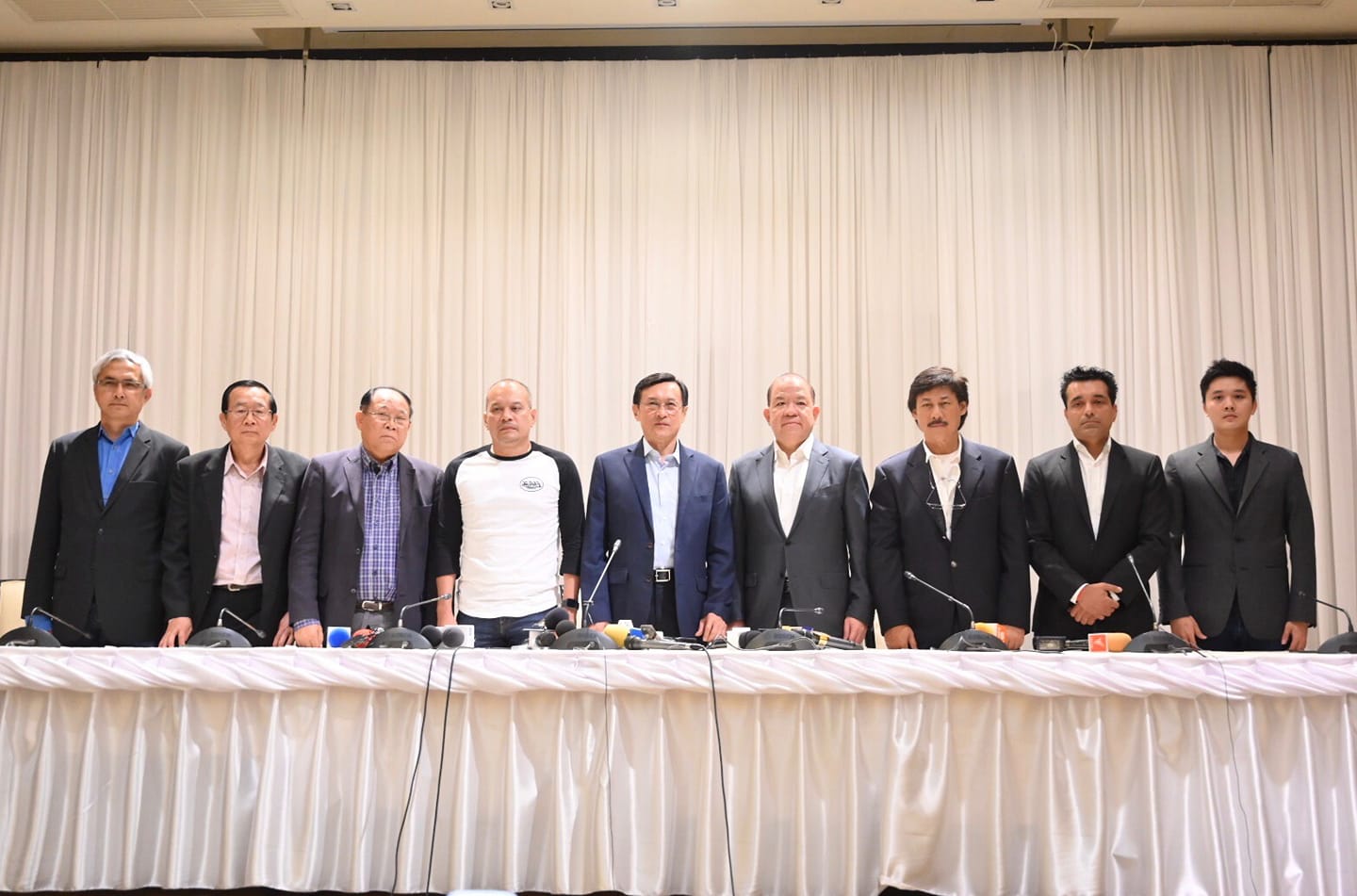
The leaders of Thai Raksa Chart at a post-dissolution press conference. Image: Noppakow Kongsuwan
The Thai Constitutional Court operates within a broader judicial structure which, despite being structurally independent, provides legitimation to the regime. The Supreme Court, following a long tradition, validated the military coup and shielded the coup-makers from prosecution, while the Supreme Administrative Court enforced the ban on judicial review of decrees issued by the junta. The Supreme Court and the Supreme Administrative court enforced the amnesty for the coup-makers and immunity for their acts—immunity which is enshrined in the interim Constitution—respectively.
From 2006 to 2014, the Thai Constitutional Court protected the interests of the army by controlling the rules of the game both at the input-level (banning political parties, disqualifying Members of Parliament, invalidating elections) and output-level (declaring legislation as well as constitutional amendments unconstitutional and void). Yet the Court has at times also constituted “pockets of liberalism”, such as in “less politicised” areas of human rights (such as children´s rights, women´s rights and environmental rights, depending on context). This is a common strategy of courts aimed at maintaining their legitimacy, which is derived in part from their perceived independence. Another important component of judicial legitimacy stems from perceived professional rather than political modes of judicial reasoning.
The Court’s strategic use of judicial reasoning
The Thai Raksa Chart case was forwarded to the Constitutional Court by the Election Commission, whose members were approved by the junta-appointed legislative assembly following the sacking of the Commission’s former president by junta decree in 2018. But the Court’s ruling on Thai Raksa Chart showed a concern not to appear as a pawn of the regime.
The Court’s legal arguments and modes of interpretation are indeed framed in widely accepted liberal-democratic traditions of judicial modes of reasoning. The 25-page ruling examines the following questions: whether the political party must be dissolved for violating Article 92 of the 2017 Political Party Act; and whether, as a result of this, its executive board members must be banned from politics and for how long. Article 92 of the 2017 Political Party Act states:
When the Election Commission has evidence that one political party has committed one of the following acts, it shall refer the case to the Constitutional Court for dissolution of the political party:
(1) Overthrowing (ล้มล้าง) Democracy with the King as Head of State or to gain power by unconstitutional means;
(2) Acts deemed hostile (กระทําการอันอาจเป็นปฏิปักษ์) to Democracy with the King as Head of State;
(3) Acts that violate Article 20 (2), 28, 30, 36, 44, 45, 46, 72, and 74 (of the Political Party Act)
The Article 20 of the Political Party Act in turn states, in a somewhat redundant fashion:
Political parties registered with the Election Commission Registrar are public law entities; their core objectives are to conduct political activities in accordance with the principles of Democracy with the King as Head of State and present candidates in elections.
In its 15 pages of discussion on the merits of the case, the Court uses several techniques of constitutional interpretation such as originalism, precedent, consequentialism, and systematic interpretation, among others. Hence, it mobilises with much creativity a wide array of modes of constitutional interpretation, with the notable exception of proportionality balancing (usually the standard when it comes to restriction of civil and political rights).
First, the Court defines royalty being “above politics” as a constitutional principle. To do so, it relies on a creative use of originalism. In the US, originalism refers to seeking the intent of the framers of the 1787 Constitution. The Thai Constitutional Court applies this technique by reflecting on King Prajadhipok´s intent behind Article 11 of the 10 December 1932 constitution, which stated that members of the royal family were “above politics”. The historical inquiry into Article 11’s original constitutional intent relies in turn on a telegram of King Prajadhipok dated 14 November 1932, which stated that members of the royal family should not be involved in politics, especially electoral campaigning, since this would make them the target of attacks from opponents. The ruling then relies on precedent to confirm this interpretation, by citing a case in 2000 (6/2543) whereby the Court ruled that members of the Thai royal family were not required to vote.
The Court’s deferral to King Prajadhipok´s telegram and the December 1932 constitution when using originalism is highly instructive of how the Court views the relationship between the monarchy and the constitution: the function of the constitution is not to limit the power of the king, but to reflect the king’s will—the King reigns, but does not rule. To the Court, original constituent power in 1932 belonged to King Prajadhipok, who then granted a constitution according to his will.
Second, the Court defines acts deemed in violation of this afore-defined constitutional principle. To do so, it uses consequentialism to define “hostile” as encompassing not only the direct action of overthrowing but also any act whose unintended consequences could result in the undermining of the institution of Democracy with the King as Head of State, or even simply the undermining of its growth and progress. The ruling states that in spite of good intentions, a possible prime ministership of the former princess would have a detrimental effect on Democracy with the King as Head of State. To confirm this reading, it makes an analogy with defamation law and cites former consequentialist readings of the Supreme Court.
Finally, the Court recommends dissolution for “acts deemed hostile to democracy with the King as Head of State” according to Article 92 (2)—falling short of an attempt to “overthrow” Democracy with the King as Head of State as per Article 92 (1). The mode of constitutional interpretation is “systematic” in that it refers to norms, including non-juridical norms, built on successive sedimentation of constitutional practices and interpretations over time.
The Court’s strategic use of constitutional law concepts
To build such a systematic constitutional interpretation, the ruling appropriates several constitutional law concepts. First, the ruling refers to the concept of militant democracy, calling it “self-defending democracy”. This concept, whose paternity is traced to the lawyer Karl Loewenstein who fled Nazi Germany in the 1930s, was born out of concerns about the rise of fascism in European constitutional democracies. Democracies have to defend themselves against those who plan and seek their overthrow. It gave birth to what became Article 21 (2) of the German Fundamental Law, which gives the Federal Constitutional Court the power to dissolve parties aiming to overthrowing German democracy.
The reasoning underpinning militant democracy was reproduced in the 1997 and 2007 Thai Constitutions, and is now part of Article 92, paragraph 2 of the Political Party Act. While Germany has only dissolved two minor parties over the last seventy years, the Thai Constitutional Court has extensively used this power. Over the last decade, the earlier incarnations of the Thai Raksa Chart party were dissolved twice, in 2007 and 2008, along with several minor parties, in the name of democracy. The same argument is used by the Court in its 7 March ruling: allowing a Princess, even stripped of her royal titles, to run for political office, would undermine democracy by turning Thailand into a “ruling monarchy”.
Thai politics goes to court. Again.
The Constitutional Court's decision on Thai Raksa Chart is likely to be swift but unlikely to be impartial.
The definition of Democracy with the King as Head of State has been a particular site of contestation between two schools of jurists in Thailand: the royalist school attached to unwritten customs and the constitutionalist school sticking to written law. To the royalist school, Democracy with the King as Head of State means that the Thai King enjoys a special role and status in the Thai polity. That special status allows him to act in times of crisis, for instance, provided he follows the “Ten Royal Virtues of the Righteous King” that inform what can be called a specific form of “Buddhist Constitutionalism”.
After the 2006 coup and even more after the 2014 coup, the royalist school gained prominence. Meanwhile, the constitutionalist school, represented by the group of jurists Nittirat, was silenced through martial law, the use of lese-majeste law and the Computer Crimes Act.
Despite the emphasis on Democracy with the King as Head of State, the Court was careful not to base its argumentation on the King’s 8 February Royal Command, whose legal status had been the object of much discussion among Thai lawyers. In its decision, the Court noted with pleasure however the loyalty of the party to the King (Thai Raksa Chart withdrew the candidacy after the Royal Command and apologized on social media).
Third, the Court mobilises the concept of “Constitutional Customs”. The argumentation relies on Article 5, paragraph 2 of the Thai Constitution on “constitutional customs of Democracy with the King as Head of State”—of which the Court, for the first time, gives a definition. Such customs must be practices which have been upheld for a long time and deemed “good”. This attempt at defining constitutional custom with cumulative criteria can bear some resemblance to the definition of custom as used in international law—the existence of a rule observed in a continuous and durable manner with opinion juris, the belief that this rule must be obeyed (because it is good).
Nevertheless, since 2006, Article 5 has been the site of highly contested interpretations by judicial, political and social actors, as well as Thai and foreign legal scholars. Article 5 has two somewhat contradictory paragraphs. The first strongly affirms constitutional supremacy: “The Constitution is the supreme law of the State. The provisions of any law, rule or regulation or any acts, which are contrary to or inconsistent with the Constitution, shall be unenforceable”.
However, the second refers to “constitutional customs”: “Whenever no provision under this Constitution is applicable to any case, an act shall be performed or a decision shall be made in accordance with the constitutional customs of Thailand under the democratic regime of government with the King as Head of State”. In the ruling on Thai Raksa Chart, the Court referenced Article 5 to define “Democracy with the King as Head of State” as a custom—of which the principle of royalty being “above politics” is one part, and his rule being guided by “the Ten Royal Virtues of a Righteous Ruler” as another.
Conclusion
Stable authoritarian states tend to consolidate power through legalism, in pursuit of the aims of legitimation, cooptation and repression. When the tools of militant democracy are used in a military dictatorship, the Constitutional Court becomes an agent of hegemonic preservation in service of the military. The army, in turn protects the Court. When the Future Forward Party challenged the Constitutional Court´s 7 March ruling, the army pressed contempt of court charges against its founders. As the party challenges military dominance, will the Court order its dissolution?
Like the army, courts are strategic players that seek to maximize their survival, prestige and power. But strategic interaction for self-interested hegemonic preservation does not explain the whole picture of judicial-military cooperation. Ideational factors play a high role in unifying the preferences of courts and militaries—this is one of the functions of the concept of “Democracy with the King as Head of State”, the upholding of which is at the root of claims to legitimacy by both the military and courts. In the 7 March ruling, the concept is mentioned a dozen times, and is linked with both constitutional identity and constitutional custom.
The Court has strategically built Democracy with the King as Head of State as a “constitutional custom” built on a Thai “constitutional identity” with strong religious and nationalistic overtones. Criticising it amounts to a crime of both lèse-majesté and sedition, akin to blasphemy.
Note: Thai terms used in the Ruling and their Translations
- The System of Democracy with the King as Head of State : การปกครองระบอบประชาธิปไตยอันมีพระมหากษัตริย์ทรงเป็นประมุข
- “Acts deemed hostile” (to the System of Democracy with the King as Head of State) กระทําการอันอาจเป็นปฏิปักษ์
- “overthrow” (the System of Democracy with the King as Head of State) ล้มล้าง
- Self-defending Democracy/Militant democracy กลไกปกป้องระบอบ
- Constitutional custom ประเพณีการปกครองประเทศไทยในระบอบประชาธิปไตยอันมีพระมหากษัตริย์ทรงเป็นประมุข vs Royal conventions นิติราชประเพณี
- Constitutional identity การปกครองระบอบประชาธิปไตยอันมีพระมหากษัตริย์ทรงเป็นประมุขเป็นเอกลักษณ์เฉพาะของประเทศไทย
- Ruling monarchy ระบอบราชาธิปไตยอำนาจสมบูรณ์ vs Constitutional Monarchy ประชาธิปไตยภายใต้รัฐธรรมนูญ
- The King reigns, but does not rule พระมหากษัตริย์ทรงราชย์แต่มิได้ทรงปกครอง
This article was based on a talk held on 13 March 2019 at the National University of Singapore. The author would like to thank workshop participants for their stimulating questions, as well as the Faculties of Political Science, NUS in Singapore and Humboldt University in Berlin, and the Chair of Comparative Constitutionalism in Göttingen, for funding, especially Ran Hirschl.
 Facebook
Facebook  Twitter
Twitter  Soundcloud
Soundcloud  Youtube
Youtube  Rss
Rss 
